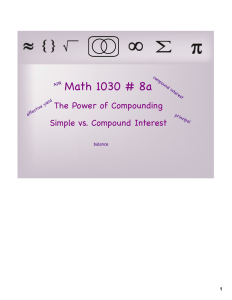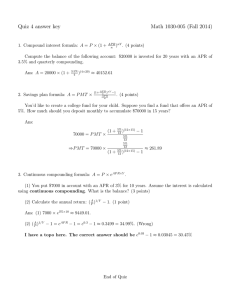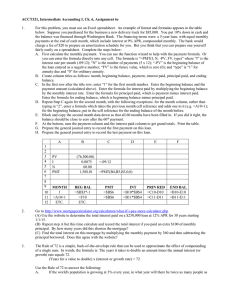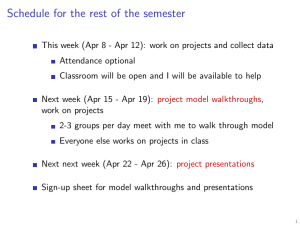Assignment 6 Math 1030 Due Friday, October 19th
advertisement
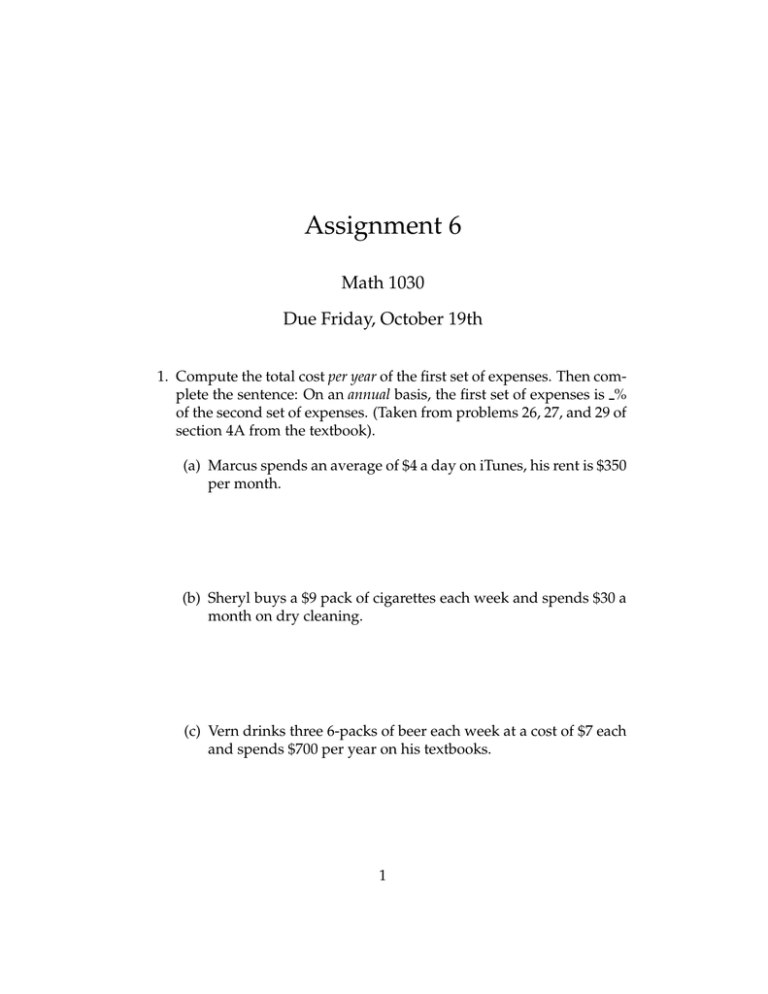
Assignment 6 Math 1030 Due Friday, October 19th 1. Compute the total cost per year of the first set of expenses. Then complete the sentence: On an annual basis, the first set of expenses is % of the second set of expenses. (Taken from problems 26, 27, and 29 of section 4A from the textbook). (a) Marcus spends an average of $4 a day on iTunes, his rent is $350 per month. (b) Sheryl buys a $9 pack of cigarettes each week and spends $30 a month on dry cleaning. (c) Vern drinks three 6-packs of beer each week at a cost of $7 each and spends $700 per year on his textbooks. 1 2. You currently drive 250 miles per week in a car that gest 21 miles per gallon of gas. You are considering buying a new fuel-efficient car for $16,000 (after trade-in on your current car) that gets 45 miles per gallon. Insurance premiums for the new and old car are $800 and $400 per year, respectively. You anticipate spending $1500 per year on repairs for the old car and having no repairs on the new car. Assume gas costs $3.50 per gallon. Over a five-year period, is it less expensive to keep your old car or buy the new car? (Problem 51 from section 4A of the textbook.) 3. You could take a 15-week, three-credit college course, which requires 10 hours per week of your time and costs $500 per credit-hour of tuition. Or during those hours you could have a job paying $10 per hour. What is the net cost of the class compred to working? Given that the average college graduate earns nearly $20,000 per year more than a high school graduate, is it a worthwhile expense? (Problem 47 from section 4A of the textbook.) 2 4. Yancy invests $5000 in an account that earns simple interest at an annual rate of 5% per year. Samantha invests $5000 in a savings account with annual compounding at a rate of 5% per year. Make a table that shows the performance of both accounts for 5 years. The table should list the amount of interest earned each year and the balance in each account. Compare the balances after 5 years. (Problem 45 from section 4B of the textbook.) 3 5. Use the compound interest formula to determine the accumulated balance after the stated period. Assume that interest is compounded annually. (Problems 47-52 from section 4B of the textbook.) (a) $3000 is invested at an APR of 3% for 10 years. (b) $10,000 is invested at an APR of 5% for 20 years. (c) $40,000 is invested at an APR of 7% for 25 years. (d) $3000 is invested at an APR of 4% for 12 years. (e) $8000 is invested at an APR of 6% for 25 years. (f) $40,000 is invested at an APR of 8.5% for 30 years. 4 6. Use the compound interest formula for compounding more than once a year to determine the accumulated balance after the stated period. (Problems 53 through 60 from section 4B of the textbook.) (a) A $4000 deposit at an APR of 3.5% with monthly compounding for 10 years. (b) A $2000 deposit at an APR of 3% with daily compounding for 5 years. (c) A $15,000 deposit at an APR of 5.6% with quarterly compounding for 20 years. (d) A $10,000 deposit at an APR of 2.75% with montly compounding for 5 years. 5 (e) A $2000 deposit at an APR of 7% with monthly compounding for 15 years. (f) A $3000 deposit at an APR of 5% with daily compounding for 10 years. (g) A $25,000 deposit at an APR of 6.2% with quarterly compounding for 30 years. (h) A $15,000 deposit at an APR of 7.8% with monthly compounding for 15 years. 6 7. Find the annual percentage yield (APY) for the banks described below. (Problems 61 through 64 from section 4B of the textbook.) (a) A bank offers an APR of 3.5% compounded daily. (b) A bank offers an APR of 4.5% compounded monthly. (c) A bank offers an APR of 4.25% compounded monthly. (d) A bank offers an APR of 2.25% compounded quarterly. 7 8. Use the compound interest formula for continuous compounding to determine the accumulated balance after 1 year, 5 years, and 20 years. Also find the APY for each account. (Problems 65 through 67 of section 4B of the textbook.) (a) A $3000 desposit in an account with an APR of 4%. (b) A $2000 deposit in an account with an APR of 5%. (c) A $10,000 deposit in an account with an APR of 8%. 8 9. At age 35 you start saving for retirement. If your investment plan pays an APR of 6% and you want to have $2 million when you retire in 30 years, how much should you deposit monthly? (Problem 54 from section 4C of the textbook.) 10. Compute the total and annual return of the described investments. (Problems 59 through 61 of the textbook). (a) Five years after buying 100 shares of XYZ stock you $60 per share, you sell the stock for $9400. (b) You pay $8000 for a municipal bond. When it matures after 20 years, you receive $12,500. (c) Twenty years after purchasing shares in a mutual fund for $6500, you sell them for $11,300. 9

